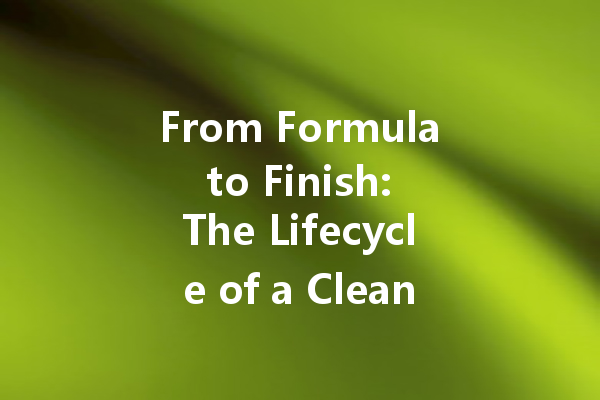Introduction
Cleaning products play an essential role in maintaining hygiene and cleanliness in our homes, offices, and public spaces. However, few people understand the complex journey these products undergo from their initial formulation to when they reach the consumer’s hands. This article explores the lifecycle of a cleaning product, highlighting the various stages involved in creating effective and safe cleaning agents.
Formulation: The First Step
At the heart of every cleaning product is its formulation. This process involves selecting a combination of ingredients that will achieve the desired cleaning efficacy while also ensuring safety for users and the environment. Chemists and product developers carefully consider several factors during this stage:
Ingredient Selection
Choosing the right ingredients is crucial. Manufacturers often use surfactants, enzymes, and solvents, each playing a specific role in cleaning. For example, surfactants help break down grease and dirt, while enzymes can target specific stains like proteins and fats. Additionally, many manufacturers strive to incorporate eco-friendly ingredients to meet growing consumer demand for sustainable products.
Balancing Performance and Safety
Formulators face the challenge of achieving a balance between product performance and safety. Certain chemicals may enhance cleaning power but could pose risks to health or the environment. As a result, many companies conduct extensive research and development (R&D) to find effective alternatives that comply with safety regulations.
Testing and Quality Control
Once a cleaning product is formulated, it undergoes rigorous testing before it can be brought to market. This stage ensures that the product performs as intended and adheres to safety standards.
Efficacy Testing
Manufacturers conduct efficacy tests to measure how effective a cleaning product is at removing stains, dirt, and germs. This can involve laboratory testing, where products are pitted against various contaminants to assess their cleaning performance.
Safety Testing
In addition to performance testing, safety assessments are crucial to ensure that the product does not pose risks to users. This includes checking for skin irritation, allergies, and other potential side effects. Regulatory agencies often require full safety data sheets detailing all ingredients and their potential risks before granting approval for market release.
Production: Bringing the Product to Life
After successful testing, the product is ready for production. This stage can vary significantly depending on the scale of production and the complexity of the cleaning product.
Manufacturing Processes
Most cleaning products are produced in large batches in manufacturing plants. The process typically involves mixing the selected ingredients in specific ratios, followed by heating, cooling, or other processes to ensure that the product reaches the desired consistency and efficacy.
Quality Assurance

Quality assurance remains critical throughout the production process. Manufacturers implement strict controls to monitor quality at every stage, ensuring that every batch meets the established standards for performance and safety.
Packaging: Protecting the Product
Once produced, the cleaning product must be packaged appropriately for distribution and sale. The packaging serves multiple purposes:
Safety and User Information
Packaging not only protects the product during transportation but also provides essential information to consumers. Labels typically include usage instructions, safety precautions, and ingredient lists, allowing consumers to make informed choices regarding the products they use in their households.
Environmental Considerations
In recent years, there has been a significant push towards sustainable packaging solutions. Many manufacturers are exploring biodegradable and recyclable packaging options to reduce waste and environmental impact.
Distribution: Getting to the Consumer
With packaging complete, the next step is distribution. Cleaning products are typically sent to various retailers, wholesalers, and distributors, making them accessible to consumers.
Logistics and Supply Chain Management
Efficient logistics and supply chain management are vital in ensuring that products reach the market in a timely manner. Manufacturers must coordinate with transportation companies, warehouses, and retailers to manage inventory and ensure that the product is available when and where consumers want it.
Marketing and Sales: Connecting with Consumers
Once the product is available in stores or online, marketing efforts are crucial to encourage sales.
Branding and Promotion
Effective marketing strategies include branding that resonates with the target audience, advertising campaigns, and promotions that highlight the product’s benefits. Many brands emphasize eco-conscious ingredients and effective cleaning properties to attract health-conscious and environmentally aware consumers.
Customer Feedback and Improvement
After the product hits the shelves, obtaining customer feedback is essential for ongoing improvement. Manufacturers often encourage reviews and gather insights to refine their formulas, packaging, and marketing strategies based on consumer preferences and trends.
Conclusion
The lifecycle of a cleaning product, from its initial formulation to the point where it reaches consumers, is a multifaceted journey that involves careful planning, rigorous testing, and strategic marketing. As consumer demands evolve towards more eco-friendly and effective cleaning solutions, manufacturers must adapt their practices to ensure that they not only meet safety and performance standards but also promote sustainability. Understanding this lifecycle helps consumers appreciate the complexities behind the cleaning products they use every day and encourages informed decision-making for a cleaner, safer environment.
